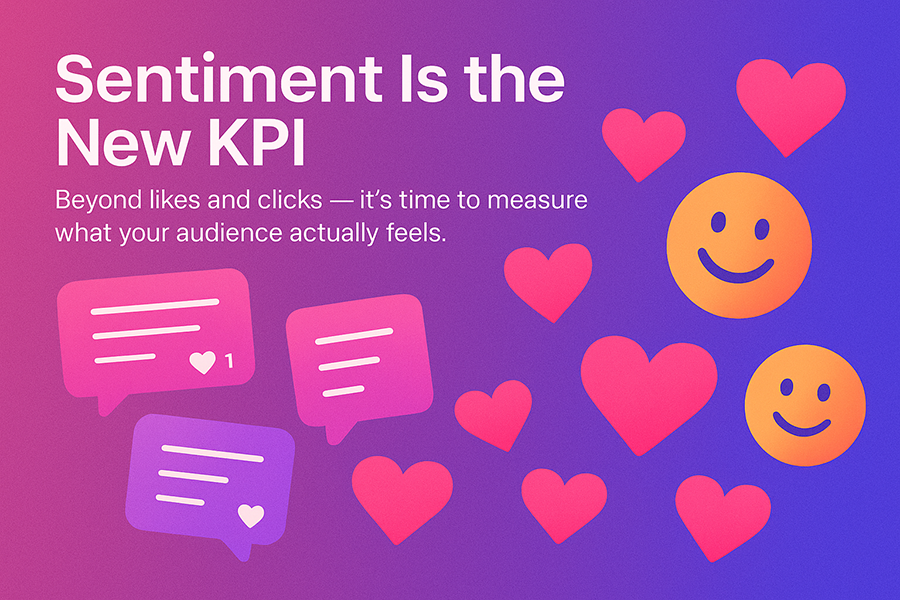Sentiment Is the New KPI: Why Feelings Are the Real Metric That Matters
October 29, 2025
Beyond likes and clicks it's time to measure what your audience actually feels.

In social media, it’s easy to get hypnotized by the numbers, the views, the likes, the follower count climbing (or not). But when you strip it down, what every creator and brand really wants to know is: Do people actually care?
That’s where sentiment comes in. It’s not just data; it’s emotion, tone, reaction. It’s the sigh someone lets out when they see your post, the spark of joy when they share your reel, or the quiet frustration behind a comment that says, “Wish you’d gone deeper.”
Tracking sentiment means tracking how your audience feels, and that’s something traditional KPIs just can’t capture.
Why Sentiment Matters More Than Ever
We live in an era of emotional algorithms. People don’t follow brands; they follow what moves them. When you measure sentiment, you’re measuring trust, relatability, and how well you’re connecting on a human level.
A thousand likes can’t tell you if your audience feels inspired or indifferent. But sentiment can.
- It helps explain
why a campaign worked, not just that it did.
- It lets you see the dip before it shows up in your sales report.
- It turns surface-level engagement into meaningful connection.
Think of sentiment as your early-warning system or better yet, your emotional radar.
What to Measure (Without Losing Your Mind)
Don’t overcomplicate it. You don’t need a PhD in data to understand your audience’s feelings, just curiosity and consistency.
Start with a few key questions:
- Are people positive, negative, or neutral toward your content right now?
- What emotions are trending up or down over time?
- Which themes or formats drive the strongest feelings?
- Does that sentiment differ between new followers and longtime fans?
If you notice your posts about “behind the scenes” consistently spark warm, excited comments, that’s your signal. Do more of that. If followers are rolling their eyes (literally, with the emoji) at another promo post, that’s sentiment too.
How to Read the Room
Sentiment data isn’t just for analysts. It’s for creators who care.
When you read comments, don’t just tally the positive and negative; listen between the lines. Are people feeling heard? Understood? Excited? Confused?
Here’s how to make it actionable:
- Watch for
shifts, not spikes. One bad comment isn’t a crisis; a steady tone change is.
- Pair sentiment with performance. If sentiment drops but views rise, it might mean your reach is growing faster than your resonance.
- Follow the feelings. A pattern of gratitude or humor means your tone is landing; a wave of frustration means it’s time to clarify, simplify, or just be real for a minute.
Turning Feelings Into Strategy
Creators who get this right don’t just monitor sentiment, they respond to it.
- When a community manager at Nike noticed fans praising authenticity over polish, the brand shifted its visuals to feature real athletes, not models.
- When Starbucks saw confusion around a new drink, they didn’t double down; they reformulated it and used the feedback as part of the comeback story.
You can do the same thing, no matter your size.
- If people feel left out, host a Q&A or go Live.
- If they’re excited: pin their comments and build a UGC moment around them.
- If they’re critical: thank them, fix it fast, and show them you listened.
That’s not just community management. That’s brand building.
Bringing Sentiment Into Your KPI Mix
To make sentiment work for you, treat it like a recurring pulse check:
- Set your intent. What do you want to feel from your audience: trust, excitement, curiosity?
- Track trends over time. Use simple sentiment analysis tools or even your own gut; the consistency is what matters.
- Report both the number and the narrative. A 70% positive score is great, but
why it’s rising (a better tone, a new topic, more honest captions) is what you’ll build on.
- Close the loop. Show your audience that their feedback mattered. That’s how you turn a one-time follower into a fan.
The Heartbeat of Every Creator
At the end of the day, sentiment isn’t about charts and dashboards; it’s about empathy. It’s how you sense the pulse of your audience without them having to spell it out.
When you measure what people feel, not just what they do, you stop guessing what will resonate, and start knowing.
Because in a world driven by algorithms, humanity is still the ultimate KPI.
Frequently Asked Questions
What exactly is sentiment analysis in social media?
Sentiment analysis is the process of understanding how your audience feels about your content, brand, or products. Instead of only counting likes or comments, it reads the emotional tone behind them—positive, negative, or neutral—so you can see the story behind the stats.
Why is sentiment a better KPI than engagement rate alone?
Engagement shows what people did; sentiment reveals why they did it. A post can rack up likes while still leaving your audience frustrated or indifferent. Sentiment fills in the emotional gap, helping you create content that not only performs but connects.
How can creators measure sentiment easily?
You don’t need complicated software. Stampede Social measures sentiment automatically at both the Instagram post and comment level—so you can instantly see how followers feel about each piece of content, campaign, or conversation. It’s simple, accurate, and built for creators who want real insight without extra effort.
What’s a good sentiment score?
There’s no universal “right number.” A healthy benchmark is seeing more positive sentiment than negative over time—and, more importantly, seeing steady improvement. The real value is in trend direction: are people feeling better about your brand each month?
How can I use sentiment data to improve my content strategy?
Look for emotional patterns. If followers feel inspired by your tutorials but annoyed by hard sells, adjust your mix. If people love your humor, double down on it. Sentiment shows you not just what’s working, but what’s worth amplifying.


